Get to Know Anna: Principal and Landscape Architect
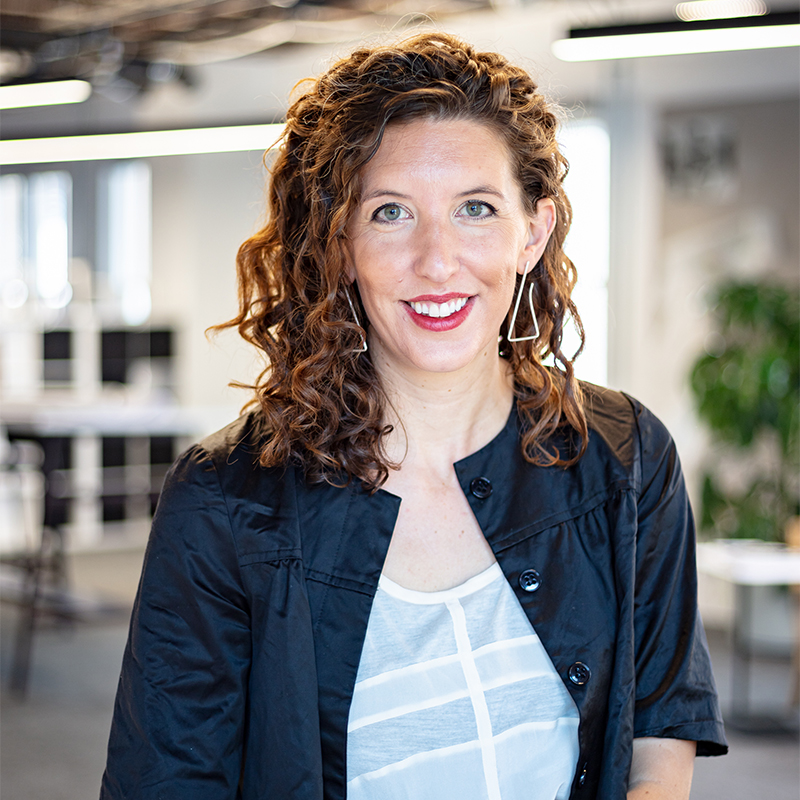
 Sasaki
Sasaki

Anna Cawrse, ASLA, PLA has been promoted to principal. Cawrse is responsible for leading significant public realm projects throughout North America and Europe. Cawrse is the co-director of Sasaki’s Denver office. With expertise that spans parks and open space, public plazas, and urban corridors and districts, Cawrse is internationally recognized for her ability to transition master planning of the public realm into realized space. Cawrse has dedicated her career to weaving nature, culture, and history into urban landscapes. At every scale, she is committed to engaging communities and strives to create designs that reflect both the current and future communities’ needs.
“Anna is one of the most energetic and empathetic leaders I have collaborated with in my career. She has a unique ability to merge poetic design ideas with an innate sense of practicality that results in beautiful yet achievable outcomes,” says Michael Grove, Sasaki principal and chair of landscape architecture, civil engineering, and ecology. “With a clear vision for the future of our practice at Sasaki as well as for the profession of landscape architecture to address the complex challenges of our time, Anna inspires her teams with a deep sense of purpose and commitment. Her ability to engage, listen, process, and incorporate the ideas of others leads to powerful outcomes where everyone is a valued collaborator, providing critical insights that makes the work stronger.”
Learn more about what drives Anna in her work and in her new role as principal:
What makes you tick?
I love having the opportunity to talk to a community to better understand what they want, and then creating a design that responds to their needs today and down the line. It’s so important that the built work reflects the community’s voice. What I love more than anything is the moment when someone comes to a project and recognizes their ideas are now a part of the space.
Is there a project that changed the way you looked at your job?
Designing Bonnet Springs Park, in Lakeland, FL was a pivotal moment for me—it was at that time, the largest and most complex park I designed. It was an immensely technical project that required all of Sasaki’s disciplines to help transform 168-acres that was previously a brownfield into a cultural and ecological jewel for the community. Community engagement helped us uncover a lot of challenges and needs at Bonnet Springs Park, and we made an effort to share back the technical aspects of the project’s environmental challenges. Now that the project is open to the public, it’s incredible to see what started out as sketches that looked at both form and function become a new community space.
Having such an interdisciplinary team on Bonnet Springs Park helped us tackle some of the site’s huge challenges like water quality issues, remediation, and soil contamination, and it also allowed us to integrate architecture thoughtfully into this challenging environment. Being at an interdisciplinary firm allows you to back and forth in real time to come up with ideas and issues early on in the process. We never could have come to the solutions we found if we had been siloed in different practices.
“Being a female principal and a mother, I feel a responsibility to empower my female peers and show other young women that you can be a designer on some of the most complex projects, become a full partner, and have a family.”
-Anna Cawrse, principal
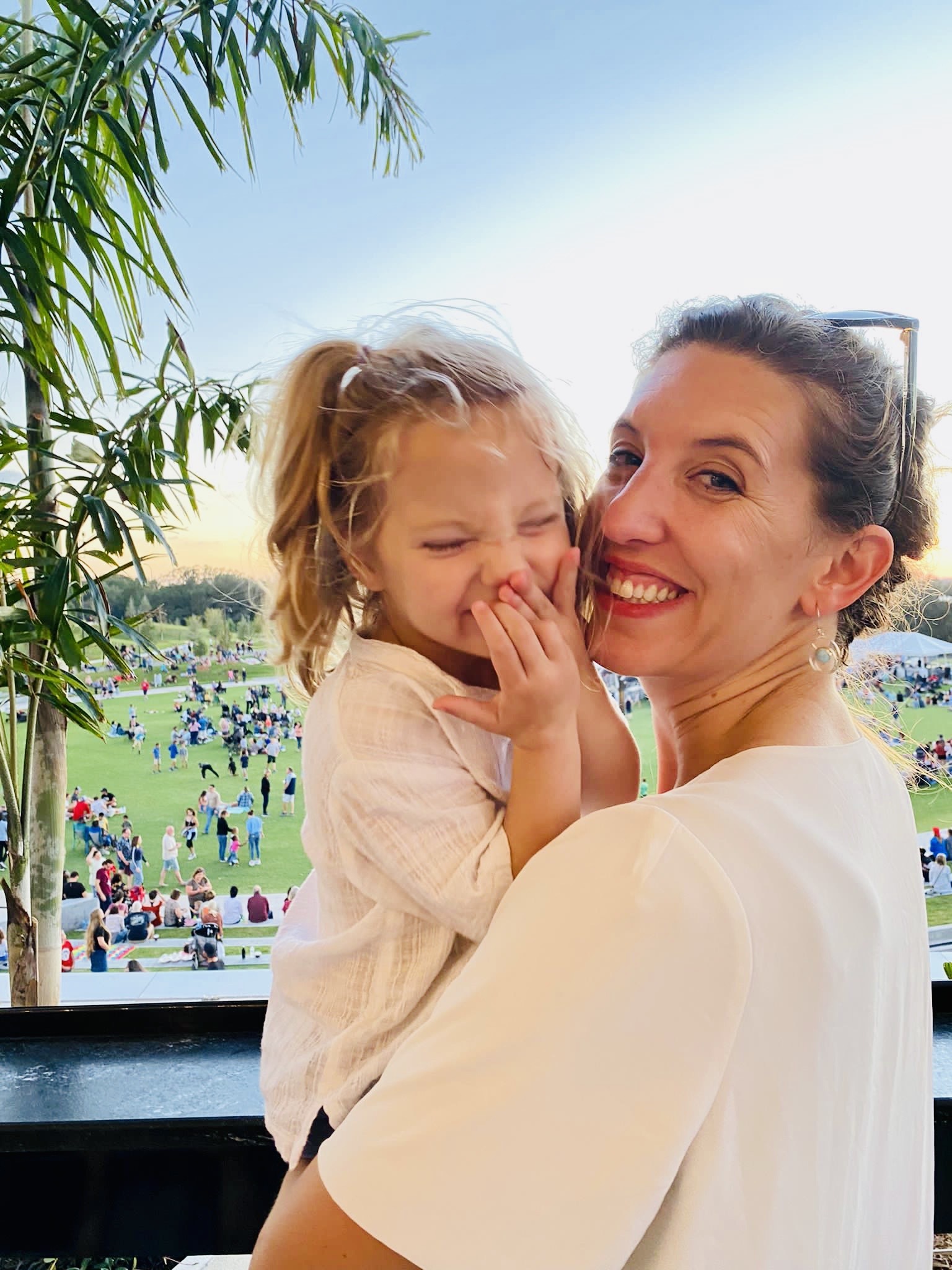
Cawrse celebrated the opening of Bonnet Springs Park in Lakeland, FL with her family
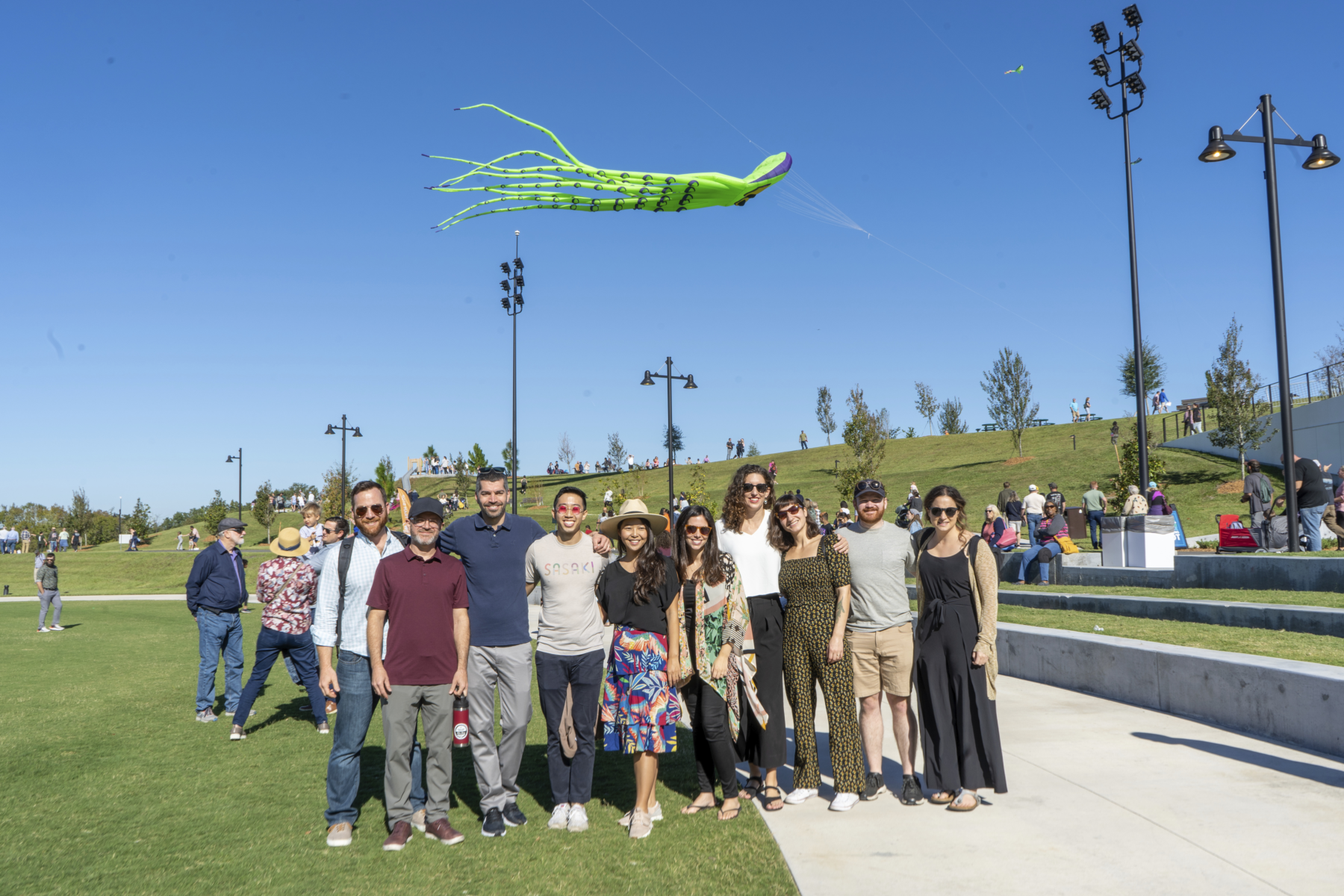
The Sasaki design team at the Bonnet Springs Park opening
What are you most excited about in your new role as principal?
Empowering people. It’s crucial to be humble when creating spaces for other people to use. As a principal, I want our work to empower communities. I want to see a direct line where our community engagement leads to actions that then lead to implementation.
I also want to empower the landscape itself. My time spent designing a project is so small compared to the longevity of the landscape’s timeline, I’m really only here for a single moment! I want to make sure I create a design that will constantly evolve so that the environment can continue to be a community canvas long after I leave.
I also feel a huge responsibility, as lead designer on a project, to empower my teams to bring their full selves to a project. I am working with some of the smartest people I’ve ever met, and I want them to shine and feel comfortable designing as a team. Being a female principal and a mother, I feel a responsibility to empower my female peers and show other young women that you can be a designer on some of the most complex projects, become a full partner, and have a family. During my time here, I’ve been able to grow such a broad practice at Sasaki and have felt so supported to do so while also choosing to raise a family.
What keeps you up at night?
You know, I could say it’s a certain project, but in all seriousness, it’s my kids. When I go home, I’m a mom to twins. It’s not sustainable to constantly blur the lines between work and family, so I’ve been very conscientious about keeping mom time separate from my time as a partner and principal landscape architect. That being said, I love bringing my kids to the office and to my parks!
I talk to my kids about the projects that I do, because I feel so strongly about creating great spaces that other kids around the country will get to play in. I want my kids to know that I love what I do—and also that I love them more than what I do. It’s important for them to know that, too.
How do you approach designing in an era of climate change?
For me, resilient design is embedded in every project I do. I’m excited that cities are becoming very interested in designing for climate change, whether that means choosing drought tolerant species, conserving water within the site, or designing for fires. We’re seeing more and more unprecedented events—like a dry hurricane, which is a hurricane without any rain, out in Salt Lake City—and we can use our knowledge of climate change and its impacts to inform our designs and make spaces that are comfortable for humans and will be resilient in the future.
In order to tackle climate change, we must have a shift in understanding on both the macro and micro scale. I think this is exemplified in the research I led at Sasaki with NRPA, Climate.Park.Change. The tool looks at resilient system-wide strategies and also looks at the individual choices you can make for your park, down to even the individual kind of tree you’d want to plant.
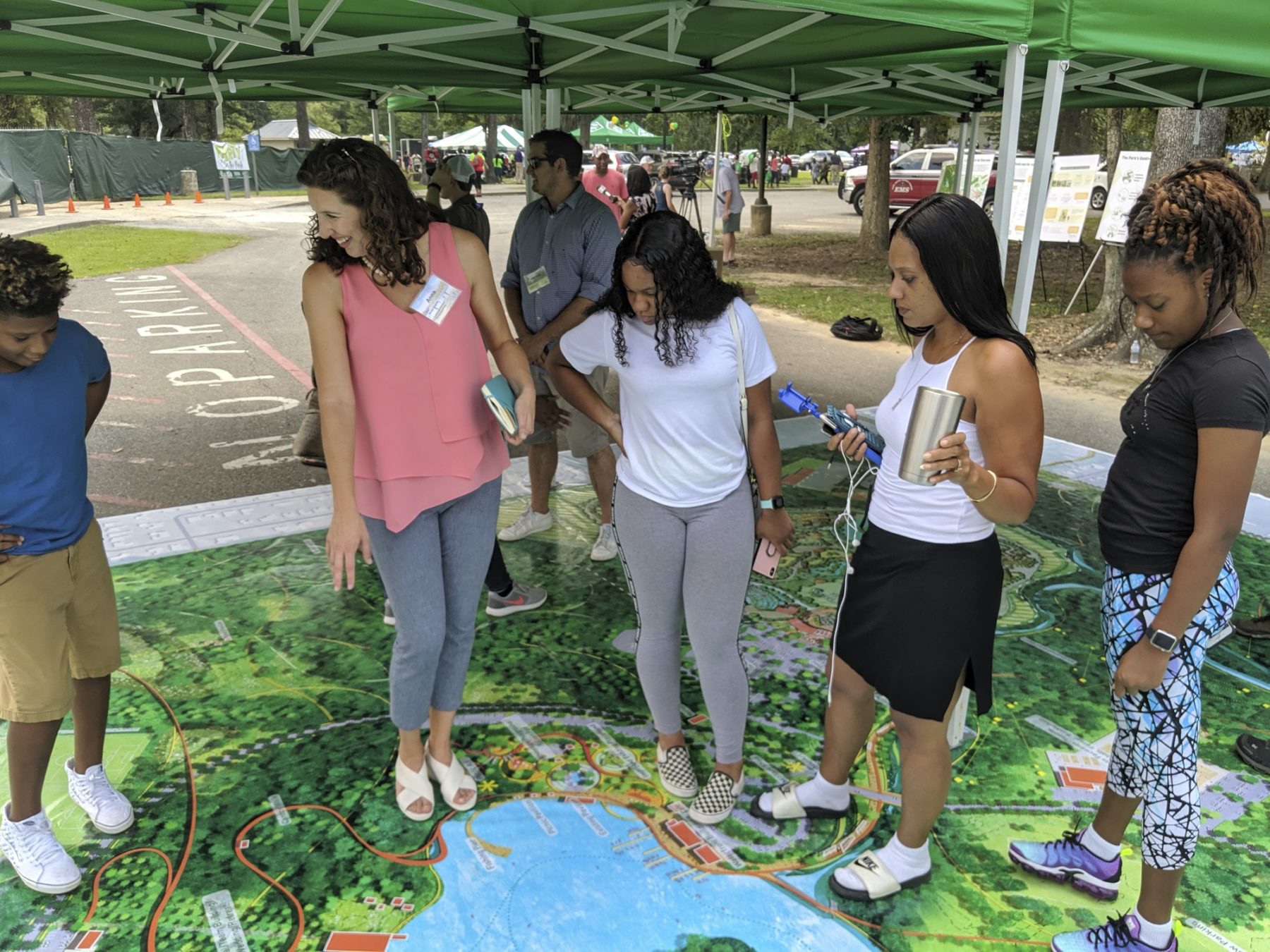
Cawrse interacting with the 30’ square print out of Greenwood Community Park Master Plan and Implementation at the project’s final public meeting. “Enhancing the park’s natural assets and ensuring that this community has equitable access to high quality, beautiful, enriching outdoor amenities was our guiding goal throughout this planning process,” says Cawrse.
What do you see as the next frontier in landscape architecture?
I think we are going to continue building complex urban public spaces as we’re seeing an influx of people moving into cities. People are realizing the importance of gathering in open space and parks, and that has put pressure on cities to provide them, whether that means rethinking the existing spaces or getting creative to find new spaces within the city. I’m really excited about working with cities to solve all kinds of challenges that arise, like environmental issues, creating equitable access, and finding a balance between active and passive spaces for people to enjoy.
We’re seeing this kind of approach with projects with Bonnet Springs Park, which I talked about earlier. In Athens, Greece we are converting the old airport into Europe’s largest urban waterfront park. We’ve also been shortlisted in a really exciting competition to design a new urban waterfront for Lake Monona in Madison, WI. It’s really a once-in-a-generation opportunity to shape the future of Madison’s waterfront, and I feel excited about how Sasaki can help them tackle their design challenges. Gene Reid Park, in Tucson, AZ is another one I am thrilled to be working on. They have been one of the most engaged communities I have ever worked with, and it’s been great working with them to envision a park that reflects their authentic, unique spirit.
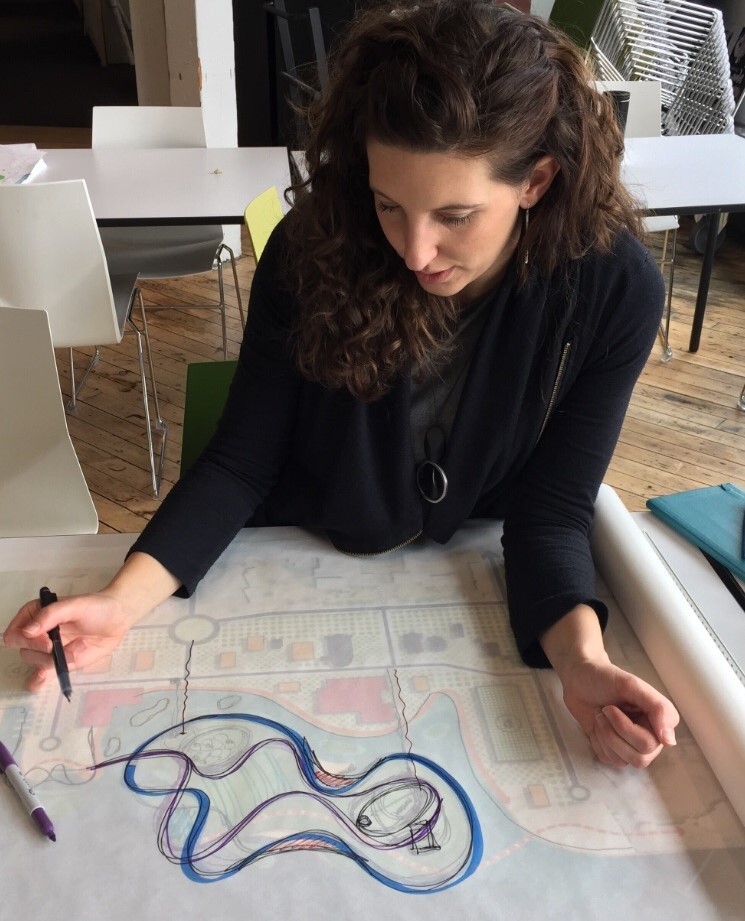
Do you have any advice you would give yourself 10 years ago?
You have to cut yourself slack and be kind to yourself—you’re never going to get everything right. But know that you are doing the best that you can, and that’s great. And be confident!
Don’t think of where you came from as something to overcome, but as strength leading to where you are today. I grew up in tiny, rural towns, and found my way to Harvard, a school that I never thought I would attend. I felt self-conscious for a long time that I was not as academic as some of my colleagues. But I’ve realized that being my full, authentic self actually helps me connect with communities. My background actually sets me apart in the profession, it doesn’t hold me back.